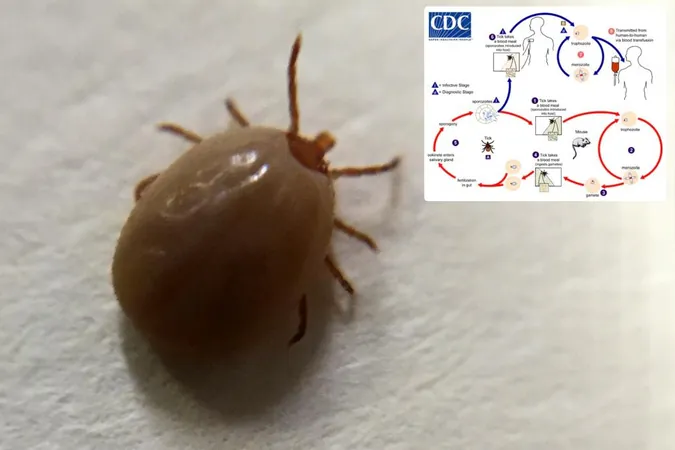
What You Need to Know About Babesiosis: The Surging Tick-Borne Threat
2024-10-08
Author: Jia
Overview of Babesiosis
You may be familiar with Lyme disease, but a new warning from infectious disease experts is turning heads: babesiosis, a potentially deadly tick-borne disease, is on the rise. Residents of endemic areas—especially in the Northeast and Midwest—should take precautions. “Take precautions, especially during the summer months,” cautioned Paddy Ssentongo, infectious disease fellow at Penn State Health Milton S. Hershey Medical Center.
Recent research shows that from 2015 to 2022, the incidence of babesiosis increased by an alarming average of 9% annually in the United States. Compounding this issue, nearly 40% of affected individuals were also diagnosed with Lyme disease or other tick-borne illnesses.
The Culprit: Climate Change?
Ssentongo attributes this increase to shifting climate patterns, including changes in the length and temperature of seasons, humidity, and rainfall, all of which significantly influence tick populations. The findings were published in the journal *Open Forum Infectious Diseases*.
Understanding Babesiosis: The Basics
Babesiosis is caused by the Babesia parasite, primarily transmitted through the bite of black-legged ticks, commonly known as deer ticks. Just like malaria, Babesia infects red blood cells. Transmission can also occur through blood transfusions, organ transplants, and from mother to child.
In a study conducted by the Penn State team, they identified 3,521 cases of babesiosis between October 2015 and December 2022, with a majority of infections occurring during the summer months in Northeastern states. The findings revealed that 42% of babesiosis patients had at least one other tick-borne disease. Among these, 41% were co-infected with the Lyme disease bacterium, while lesser percentages showed signs of ehrlichiosis (3.7%) and anaplasmosis (0.3%).
Fatality Rate: A Silver Lining?
While fatalities from babesiosis are rare, the U.S. death rate in 2019 was recorded at 0.57%. The states most affected included New York, Massachusetts, and Maryland. Interestingly, Ssentongo found the risk of death was higher among those solely infected with babesiosis than among those with co-infections.
“Having both babesiosis and Lyme disease seemed not to be associated with worse mortality,” he noted. It’s speculated that co-infections may enhance the immune response, allowing for better handling of the parasites.
Recognizing the Symptoms
Not everyone infected with Babesia will exhibit symptoms. According to the Centers for Disease Control and Prevention, some might develop flu-like symptoms a week after infection, while others might notice signs several weeks later. Common symptoms include: - Fever - Chills - Sweats - Headache - Body aches - Loss of appetite - Nausea - Fatigue
At-Risk Populations
The disease is particularly dangerous for older adults or those with weakened immune systems, liver or kidney diseases, or those without a spleen. Dr. Bruce Hirsch, attending physician for the Northwell Health Division of Infectious Disease, stresses the importance of reducing exposure to ticks, especially for vulnerable populations, stating that “in young and healthy individuals, infection is barely noticeable, but for the more susceptible, babesiosis can be deadly.”
Treatment and Prevention
A blood test can confirm the presence of the Babesia parasite. Treatment typically involves antibiotics such as azithromycin and atovaquone. In severe cases, patients might undergo an exchange procedure to replace sick blood cells with healthy ones.
Ssentongo mentions that for patients with babesiosis, clinicians often add doxycycline while investigating potential Lyme co-infections, which has shown promising outcomes at their medical center, although more research is required to validate this approach.
To protect yourself from babesiosis and other tick-borne diseases, experts recommend wearing protective clothing, using insect repellent, performing regular tick checks, and maintaining a clean yard to deter ticks.
Conclusion
Don’t Become a Statistic! Stay Informed and Stay Safe This Tick Season!

 Brasil (PT)
Brasil (PT)
 Canada (EN)
Canada (EN)
 Chile (ES)
Chile (ES)
 España (ES)
España (ES)
 France (FR)
France (FR)
 Hong Kong (EN)
Hong Kong (EN)
 Italia (IT)
Italia (IT)
 日本 (JA)
日本 (JA)
 Magyarország (HU)
Magyarország (HU)
 Norge (NO)
Norge (NO)
 Polska (PL)
Polska (PL)
 Schweiz (DE)
Schweiz (DE)
 Singapore (EN)
Singapore (EN)
 Sverige (SV)
Sverige (SV)
 Suomi (FI)
Suomi (FI)
 Türkiye (TR)
Türkiye (TR)